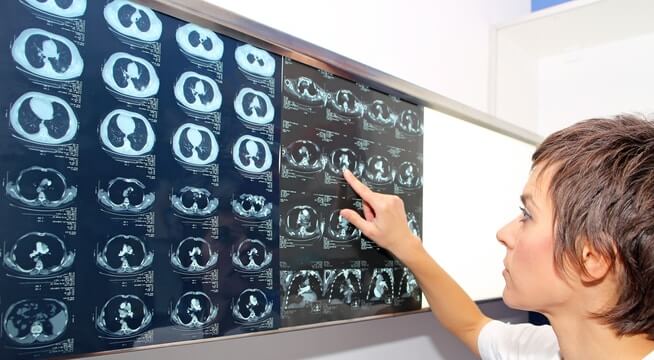Pulmonary Embolism
Conditions
•
Jan 13, 2019
Reviewed by: Jeffrey Peebles, M.D

Breathing is one of those things most people take for granted. It’s just something we do. It’s so automatic, it often falls into the background of our consciousness. At the same time, it’s as essential to life as a properly beating heart. So when you start having difficulties breathing, it’s cause for concern.
While there are several conditions that may affect a person’s breathing (such as asthma, bronchitis, or pneumonia), a pulmonary embolism is one of the most common cardiovascular diseases in the United States.
What Is a Pulmonary Embolism?
A pulmonary embolism is the medical term for when there’s an obstruction in a person’s pulmonary arteries. They are often caused by blood clots and can be fatal if left untreated. This is because such blockages can obstruct blood flow to the lungs. As if that weren’t a dire enough possibility, the clot itself can travel to the lungs.
Symptoms of Pulmonary Embolism
The signs of a pulmonary embolism can vary greatly from one person to the next. Factors that affect symptoms include the presence of an underlying medical condition, the size of the blood clots, and the location of the clots. That being said, the following signs may be an indication that a person may be suffering from a pulmonary embolism:
- Chest pain
- Increased heart rate
- Pain that worsens when coughing, eating, or doing physical exercise
- Shortness of breath
- Cough
- Blood in saliva
- Blood in mucus
- Fever
- Dizziness
- Swollen legs
What Causes Pulmonary Embolism?
The most common cause of a pulmonary embolism are blood clots, which are formed when blood pools in the blood vessels. This makes it more likely for platelets to stick together.
Artery obstruction may also be caused by fat deposits, air bubbles, amniotic fluid, or a tumor. A fat embolism tends to be more likely after fracturing one of the body’s major bones, while air bubbles are likely if there is too much carbon dioxide in the blood.
Cigarette smoke is the most common cause for an increase of carbon dioxide in the bloodstream. Other causes include kidney disorders, issues with the body’s adrenal glands, or complications of diabetes.
Pulmonary Embolism Diagnosis & Treatment
A medical provider will examine your legs to look for signs of swelling and tenderness. In addition, the patient will undergo blood testing to measure the amount of oxygen and carbon dioxide in the blood. Other possible tests include X-rays, an MRI, an echocardiogram, or a pulmonary angiography to determine how blood is flowing to the lungs.
The most common treatment for a pulmonary embolism is to prescribe blood thinners. These are essential to keep the body from producing additional clots and to prevent existing clots from getting larger.
A doctor may also recommend oxygen therapy, which can be administered either at a hospital or at the patient’s home.
Pulmonary Embolism Risk Factors
There are several risk factors that could increase the likelihood of developing a pulmonary embolism. The most common ones include:
- Having a history of blood clots
- Having a sedentary lifestyle
- Long periods of inactivity
- Undergoing surgery
- Heart disease
- Cancer; especially if it has metastasized
Complications of a Pulmonary Embolism
If the patient is prescribed blood thinners, it’s important to keep in mind that one of the side effects may include internal bleeding. This is why it’s crucial to follow all instructions.
As for the condition itself, the worst complications of a pulmonary embolism are the death of lung tissue (pulmonary or lung infarction), cardiac arrest (when a person’s heart stops beating), arrhythmia (irregular heartbeats), or pleural effusion (when lungs fill up with fluid). This is why it’s crucial to seek medical care at the first sign of difficulties breathing.
Pulmonary Embolism Prevention
As with many other medical conditions, preventing a pulmonary embolism requires long-term lifestyle changes, such as incorporating regular exercise into the patient’s schedule. This may be low-impact exercises, such as walking or swimming.
Staying hydrated and eating healthy is also essential to prevent blood clots from forming. This includes dark leafy greens, limiting animal fats (such as red meat, chicken skin, cow’s milk, cheese, butter, lard, or tallow), and adding certain spices such as turmeric and ginger to your meals.
If you’ve suffered from blood clots of the extremities before, wearing compression sleeves or socks around the affected areas will help your body reduce pooled blood.
Finally, if you’re a smoker, now would be an excellent time to stop. In addition to the long list of health ailments caused by tobacco, smoking also increases the risk of developing a pulmonary embolism.
24-Hour Emergency Room Services in Colorado Springs and Texas
If you have a history of blood clots or believe that you may have a pulmonary embolism, let us help you. If you have questions or need immediate treatment, your nearest Complete Care location is ready to help, no matter the time of day or night. We offer a variety of services to help you and your family in your time of need. No appointments are necessary.
Find the Complete Care location nearest you.
